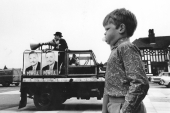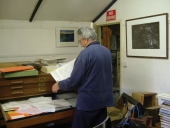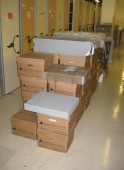Where do all the photographs go?
By Mark Bolland from The Source Photographic Review
What happens to a photographer’s work when they are no longer around to look after it? Following some recent cases of national institutions accepting photographer’s legacies Mark Bolland examines the prospects for the archives of prints and negatives they leave behind.
What happens to a photographer’s work when they die and where do the photographs go? A cynic might say that in the UK the answer is probably ‘nothing and nowhere’, and they would be right, more often than not. However, the acquisition by the British Library of Fay Godwin’s archive suggests that this bleak prognosis isn’t always accurate and some other recent examples suggest that there is hope for those who expect archives of work by prominent photographers to find their way to national collections.
In the past the V&A have conscientiously collected work by Brandt and others, although they now concentrate on contemporary practitioners as it is considerably cheaper and they have not been able to purchase work at auction since the mid-90s for similar financial reasons. On the other hand, in the last few years Professor Paul Hill has taken the unusual step of enabling Birmingham Central Library to acquire his archive during his lifetime, and Edwin Smith’s archive of 60,000 images and their copyright are now held by the Royal Institute of British Architects.
Yet the record prices currently being paid for photographs and the expense and difficulty of preserving whole bodies of work, combined with a lack of policies or facilities on the part of many institutions, who are often further hampered by a lack of government support, mean that there are no guarantees about where a photographer’s work will end up. This is an aspect of photographic practice in the UK that shows no evidence of coordination or strategy. To take two important figures in British photography as examples: this situation has meant that Jo Spence’s archive is still looked after by her former partner Terry Dennett and Raymond Moore’s archive was kept by his wife until she tried to dispose of it through an auction house. It is currently frozen in limbo due to a legal dispute.
Fay Godwin died three years ago and the British Library have now taken possession of about 11,000 of her photographs, contact sheets, negatives and letters. While she is mostly known for her poetic landscapes, Godwin also made many portraits of literary figures including Kingsley Amis, Ted Hughes and Philip Larkin. These and some accompanying correspondence between photographer and writers seem to have been instrumental in the decision to give the archive to the British Library, despite the fact that the National Media Museum in Bradford was trying to acquire the collection. Godwin’s archive went to the British Library via the ‘In Lieu of Inheritance Tax scheme’ and is now the largest single collection that they hold. The ‘In Lieu’ scheme is run by the Museum Libraries and Archives Council (MLA) and is intended to save works of art of all kinds for the nation, by allowing estates to offset the value of their collections against tax. As John Falconer, Curator of Photographs at the British Library explains: ‘The scheme accepts works of art or other collections and archives that are considered of national importance and the final destination of the items in question is decided by the MLA. The Godwin collection is the only archive that the Library has received via the route of the In Lieu scheme.’ The MLA is the government’s agency for museums, galleries, libraries and archives offering advice, support and resources. They are a non-departmental public body, sponsored by the Department for Culture, Media and Sport. Launched in 2000, the MLA replaced the Museums and Galleries Commission and the Library and Information Commission and now has responsibility for the allocation of archives and collections via the ‘In Lieu’ scheme.
The literary connection may well have been a factor in deciding the destination of the Godwin archive, as the British Library photography collection mainly consists of 19th century work, most notably a large selection of work by the pioneering WHF Talbot, and is, by its own admission, ‘weaker for the modern period’ and generally only seeks ‘to acquire material which builds on its existing strengths.’ By contrast, the National Media Museum has actively sought to acquire such collections but this task is increasingly difficult in what Greg Hobson, Curator of Photographs at the NMM, describes as a ‘climate where the perceived value of photography is so high’. Apart from the photography market he also cites concerns common to many such institutions, such as space and staffing, that prevent the NMM from taking whole archives ‘simply because they are donated’. All of which means that many precautions must be taken before donations can be accepted: ‘We have to be confident that the work is culturally valuable in the context of our collection, in relatively good condition and with provenance – in particular in relation to ownership and copyright.’ That the Godwin and Edwin Smith archives meet all these criteria, but still did not end up in Bradford, only proves how difficult and uncertain the process of acquiring someone’s archive can be, especially in the UK.
In the absence of strong governmental support, and usually without strict or organized policies, UK institutions are reliant on photographic collections simply landing in their laps. This seems to be exactly what happened in 2007, when Penelope Smail, daughter of painter, photographer and designer Curtis Moffat, ‘generously gave his extensive archive’ to the V&A. In fact it was no accident that the Moffat archive went to the V&A. Moffat was an American who lived in Britain for nearly twenty years and his first wife had consulted Cecil Beaton about what to do with the remains of the studio Moffat left behind in London when he returned to America, and Beaton had suggested the V&A. Astonishingly, the V&A have almost no acquisition budget, but they do have the facilities and are well equipped to administer such donations. The Moffat collection is now being sorted and archived, and highlights of the collection were showcased at the exhibition Curtis Moffat: Experimental Photography and Design 1923–1935 that ran from August 2007 to April 2008. Moffat was an interior designer and society photographer as well as an interesting experimental photographer who collaborated with Man Ray, and his archive contains over 1,000 photographic prints and negatives as well as press cuttings, scrap books and ephemera. And, as in the case of Godwin, it seems that things outside photography to some extent dictated the destination of this collection: Moffat’s status as a ‘pivotal figure in Modernist interior design’ proved key to the V&A’s acceptance of his legacy, just as Godwin’s literary connections were instrumental in dictating the fate of hers.
Cases such as the legacies of Godwin and Moffat suggest the lack of a national strategy and initiative on the part of some major institutions. The Tate is vague on such issues but is in the process of compiling an acquisitions policy, and the National Archives, based at Kew, only holds material from government departments, so they have lots of photographic material but not always by recognized photographers, although there are examples: Cecil Beaton, for one, was employed by the Ministry of Information during World War Two and these photos now reside at Kew. All of which tends to make the destination of a photographer’s work something of a lottery once they are no longer around to take charge. Perhaps attempting to circumvent this problem, Professor Paul Hill sold his archive to Birmingham Central Library (BCL) in 2004. But again there is more to the collection than just one person’s photos. Hill’s collection includes work by Strand, Weston, Brandt and others, as well as photos documenting the lectures and workshops at The Photographer’s Place, the study centre Professor Hill and his wife established in 1976 at their home in Bradbourne, Derbyshire. The Photographer’s Place was the first permanent residential photography workshop in the country, and hosted numerous international photographers during its twenty year existence – in itself enough for a valuable and interesting archive. However, Pete James at BCL suggests that it was not the big names or just the Photographer’s Place archive that interested them in Hill’s collection; rather it was the completeness of a collection which contains all sorts of books, ephemera and documents that provide a ‘complete picture of one person’s working life in photography’ at a key moment for British photography and photography education. Hill was also judicious in his choice of institution; BCL has the only national collection of photography in a public library with over two million items in its collection and has been recognized by the MLA and awarded ‘designated’ status by them. This means that the collection has national and international significance as a library or archive. Only 38 collections have been ‘designated’ nationally in 28 institutions.
There are, of course, examples of British institutions actively acquiring work by British photographers, of which the V&A’s close ties to Bill Brandt is perhaps the best known. Having first bought 26 of Brandt’s nudes in 1965, the V&A bought 201 more photographs by Brandt in 1978. Various others have been given as gifts since his death in 1983, and in 2003 they acquired two albums from 1928-39 compiled by Brandt’s first wife containing some 400 photographs, mainly his early experiments.
Paul Hill sorting through the Archive – Courtesy Pete James, Birmingham Library and Archive
Such enthusiasm is rare though, and the haphazard ways in which the destinies of photographer’s archives are decided has led one photographer to attempt to tackle the issue. Jem Southam has been making enquiries about this for three or four years now, meeting with a wide range of people connected to photography and discovering that there are ‘no plans, no clear thinking and no policies’ to deal with this in the UK. He suggests that the clearest example of how little interest people have taken in this issue in British photography circles can be highlighted by a comparison between the varying fortunes of two photographic legacies. One comes from the English Landscape photographer James Ravilious – son of the artist Eric Ravilious – who took over 80,000 images of rapidly disappearing rural life in Devon from the early 1970s until his death in 1999. The other is the American pioneer of colour landscape photography, Elliot Porter. Porter’s estate was bequeathed to the Amon Carter Museum, Fort Worth, Texas where it is housed in a centre that cost 25 million dollars; while Ravilious’ legacy, although it is being properly looked after, is currently awaiting a permanent home in North Devon Records Office.
Southam is putting together a research group to attempt to ensure that the same thing doesn’t keep happening. Examples of how legacies are handled in the United States, where these things seem to be much better organized, may point to some answers. As may other fields, such as literature, where there is already an acceptance of the various issues, be they legal or practical, that institutions with an interest in archives of historical significance cannot ignore much longer. Jem Southam’s research and Paul Hill’s example suggest that it is not just institutions that must start taking more responsibility when it comes to legacies, but also photographers and artists themselves, who’s job it is to organize their own work during their lifetime so that it is useful, useable and manageable when they are gone. Perhaps greater awareness of such issues on the part of institutions and practitioners will ultimately lead to not just to better practices, but also to a UK equivalent of the University of Arizona’s Centre for Creative Photography, which houses over fifty archives by Adams, Weston, Callahan, Winogrand and other luminaries of US photography. This though, is a long way off.







